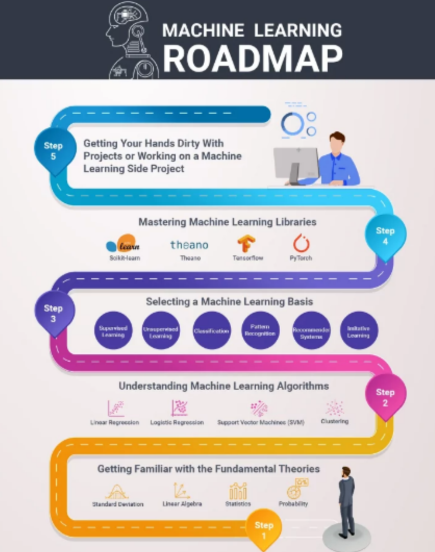Contents
The future of technology is bursting with possibilities, and the field of machine learning development stands at the forefront of this exciting evolution. If you’re passionate about making a real difference and shaping the world of tomorrow, becoming a full-time, freelancer, or remote machine learning developer in 2024 might just be the perfect career path for you! You must be thinking –
- What qualifications do I need to be a machine learning engineer?
- How long does it take to become a machine learning engineer?
- How do I start a career in machine learning engineering?
- What major do you need to be a machine learning engineer?
If you are also having such questions in your mind. This informative Guide will help you to get the answer of your queries. At RedBlink, we understand that navigating the path to becoming a proficient ML engineer involves more than just understanding algorithms; it’s about embracing a holistic approach that integrates cutting-edge technology with strategic foresight.
This comprehensive guide will equip you with the tools and knowledge you need to thrive in this ever-evolving landscape. We’ll explore cutting-edge trends and essential skills, empowering you to personalize your learning journey and unlock your full potential.
Together, let’s navigate the exciting opportunities and challenges that await you in the dynamic world of machine learning development!
But before that let’s have a look at some of the eye-opening statistics of machine Learning technology:
- The global machine-learning market was valued at USD 36.73 billion in 2022.
- The machine learning market is projected to grow at a compound annual growth rate (CAGR) of 34.8% from 2023 to 2030.
- The service segment dominated the machine learning market in 2022 with a revenue share of 51.6%.
- Large enterprises led the market in 2022, with a revenue share of 65.9%.
- North America held the largest market share in 2022, with a revenue share of 29.5%.
Source: Grand View Research
All the above-discussed statistics indicate that machine learning technology has a potential impact in almost every sector or department including, marketing, healthcare, banking, security, supply chain, etc.
This vast potential raises the need for skilled machine learning developers, the masterminds behind these transformative industries. They are the ones who translate the raw power of data into practical solutions that address real-world challenges across diverse sectors.
Unlike traditional programmers who follow specific instructions, machine learning developers are more like data wranglers and AI whisperers. They train computers to learn by themselves, feeding them massive amounts of data and guiding them to uncover hidden patterns and make predictions.
Demand for AI and machine learning specialists is expected to surge by 40%, or about 1 million jobs, from 2023 to 2027 as the utilization of AI and machine learning continues to drive industry transformation.
This indicates a highly favorable job outlook for machine learning engineers and developers, highlighting the role’s importance in the current and future technological landscape. Moreover, high-profile companies such as Apple, Adobe, and Google, among others, are actively recruiting for these roles, demonstrating the high demand for skills in this area.
Roles & Responsibilities of Machine Learning Engineer

We’ve established that machine learning developers are the masterminds behind intelligent systems, but what exactly goes into their daily work? Let’s delve deeper into the fascinating world of machine learning development.
What Does a Machine Learning Developer Do?
Imagine a detective tasked with solving a complex case. Instead of relying solely on intuition, they meticulously collect evidence, analyze it for patterns, and leverage advanced tools like fingerprint analysis to conclude. Similarly, machine learning developers are like data detectives, using the power of machine learning algorithms to solve problems. Their core responsibilities involve:
- Data Acquisition and Preprocessing: They gather relevant data from various sources, ensuring its quality and accuracy. Think of it as gathering all the clues for the detective, which might involve web scraping, database queries, or API integrations.
- Model Building and Training: Using their coding skills and expertise in algorithms like supervised learning (e.g., decision trees, random forests) and unsupervised learning (e.g., k-means clustering, principal component analysis), they create and train models that can learn from the data and make predictions. This is where the “detective work” comes in, analyzing patterns and building a framework (e.g., a neural network) for solving the problem.
- Model Evaluation and Refinement: Once a model is built, they evaluate its performance using metrics like accuracy, precision, recall, and F1 score. They identify areas for improvement and fine-tune the model with techniques like regularization or hyperparameter tuning to achieve better accuracy. It is akin to the detective refining their analysis based on new evidence.
- Deployment and Monitoring: Finally, they deploy the model into production, ensuring it runs smoothly and continues to learn and adapt over time through techniques like online learning or active learning. This is like the detective putting their solution into action and monitoring its effectiveness in the real world.
Machine Learning Skills & Tools for ML Engineer
Machine learning experts are a unique blend of data scientists, software engineers, and problem solvers. To excel in this role, they need diverse skills including:
- Programming Languages: Python (with libraries like TensorFlow, PyTorch, and sci-kit-learn), R, and Java are the most commonly used languages for machine learning.
- Mathematics and Statistics: A solid foundation in linear algebra, calculus, and probability is crucial for understanding and working with algorithms.
- Software Engineering Skills: Understanding software development best practices, version control systems (e.g., Git), and cloud platforms (e.g., AWS, Azure, GCP) is key for building, deploying, and managing models effectively.
In addition to technical skills, critical thinking, problem-solving abilities, and strong communication skills are highly valuable for machine learning developers. They need to collaborate effectively with data scientists, engineers, and other stakeholders to translate business needs into successful machine-learning solutions.
How to Become a Machine Learning Engineer [ Roadmap ]

The world of this extraordinary branch of artificial intelligence is inviting, but how do you embark on the journey to becoming a machine learning developer in this exciting field? The answer lies in cultivating a diverse skill set, and several educational pathways can equip you for success. Let’s explore the different Steps to Become a Machine Learning Engineer –
1. Formal Education Vs. Self-Taught Routes
Formal Education – This traditional path involves pursuing a degree in a relevant field, such as:
- Computer Science: Programs like Bachelor of Science in Computer Science (B.Sc. CS), and Master of Science in Computer Science (M.Sc. CS). All these degrees are good for providing a solid foundation in programming, algorithms, data structures, and software engineering principles.
- Statistics or Mathematics: Programs like Bachelor of Science in Statistics (B.Sc. Stats), Bachelor of Science in Mathematics (B.Sc. Math), Master of Science in Statistics (M.Sc. Stats), and Master of Science in Mathematics (M.Sc. Math). These degrees equip you with the necessary mathematical and statistical expertise to understand and work with complex algorithms effectively.
- Data Science: Programs like Bachelor of Science in Data Science (B.Sc. DS), and Master of Science in Data Science (M.Sc. DS). It offers specialized training in machine learning, combining the strengths of computer science, statistics, and data analysis.
Formal education structures your learning journey, offers guidance from experienced professors, and provides valuable opportunities for networking with peers and potential employers. However, it requires a significant time and financial commitment not everyone has readily available.
2. Self-Taught Route
This path relies on independent learning through various resources like:
Online Courses: Whether you choose the formal or self-taught path, supplementing your learning with online courses and certifications can be highly beneficial. These provide structured learning experiences, validate your skills, and showcase your dedication to potential employers. Popular platforms include:
- Coursera (e.g., “Machine Learning Specialization” by Andrew Ng)
- edX (e.g., “IBM: Machine Learning with Python: A Practical Introduction“)
- Udacity (e.g., “Nanodegree in Deep Learning“)
- fast.ai (“Practical Deep Learning for Coders“)
- Books and Tutorials: Resources like “Hands-On Machine Learning with Scikit-Learn, Keras & TensorFlow” by Aurélien Géron, “Machine Learning: A Probabilistic Perspective” by Kevin P. Murphy
- Open-Source Projects: Projects on platforms like GitHub (e.g., TensorFlow, PyTorch)
The self-taught route offers flexibility and often requires less financial investment. However, it demands strong self-discipline, time management skills, and the ability to effectively navigate vast amounts of online information.
3. Gaining Practical Experience
Theoretical knowledge is only the first step in your journey to becoming a machine learning developer. The real magic happens when you put your skills to the test and gain valuable hands-on experience. This practical experience is necessary for solidifying your understanding, identifying areas for improvement, and building a portfolio that showcases your capabilities to potential employers.
Importance of Hands-on Experience:
- Learning by Doing: Experientially applying your knowledge to real-world problems allows you to grasp complex concepts in a deeper and more meaningful way.
- Building Confidence: Successfully tackling challenges and completing projects boosts your confidence in your abilities and empowers you to approach new projects with a problem-solving mindset.
- Developing Practical Skills: Hands-on experience allows you to hone essential skills such as data exploration, model building, debugging, and optimizing models for real-world performance.
- Standing Out to Employers: A strong portfolio showcasing diverse projects demonstrates your practical skills and problem-solving abilities, making you stand out from the competition in the job market.
4. Participating in Kaggle Competitions
Kaggle, a renowned platform for data science and machine learning, offers a wealth of opportunities to gain practical experience through competitions involving various real-world datasets and challenges. Here’s why participating in Kaggle competitions is highly beneficial:
- Real-world Datasets: Kaggle competitions provide access to diverse datasets used in various industries, giving you a taste of the type of data you might encounter in a professional setting.
- Benchmarking your Skills: You compete and learn from a global community of data scientists and machine learning engineers, allowing you to benchmark your skills and identify areas for improvement.
- Building a Portfolio: Participating in and winning competitions adds valuable projects to your portfolio, showcasing your problem-solving skills and ability to apply machine-learning techniques to real-world problems.
- Networking Opportunities: Kaggle fosters a vibrant online Kaggle community where you can connect with fellow data enthusiasts and industry professionals, potentially leading to valuable networking opportunities.
The Roadmap to a Successful Career in Machine Learning
Pathway 1: Becoming a Full-Time Machine Learning Developer
With your educational foundation and practical experience in place, it’s time to translate your skills into a fulfilling career. Landing a full-time machine learning developer role involves actively searching job boards like
Meticulously review listings and requirements, ensuring your skillset aligns with the specific role. Craft a compelling resume that showcases your technical skills and problem-solving abilities relevant to the position.
Pathway 2: Freelancing as a Machine Learning Developer
Beyond a traditional full-time job, freelancing offers another exciting career path for machine learning experts. This route provides the freedom to:
- Choose Projects,
- Set Your Own Schedule, And
- Work Remotely.
Freelancing offers several advantages, including the flexibility and control to select projects you’re passionate about. It also enables you to manage your schedule (ideal for those seeking work-life balance or location independence).
Furthermore, freelancing also exposes you to various industries and project requirements, broadening your skillset and portfolio. Additionally, setting your own rates allows you to earn more than a traditional salary, but this depends on your experience and business acumen.
However, freelancing also comes with challenges. Finding consistent clients can be demanding, requiring proactive marketing and networking efforts on platforms like:
Unlike a fixed salary, income can fluctuate, necessitating financial discipline and planning for potential income gaps. Moreover, self-discipline and excellent time management skills are crucial for staying focused, meeting deadlines, and effectively managing your workload.
Ultimately, freelancing offers a unique path for machine learning developers but requires careful consideration of its challenges and a proactive approach to marketing your skills and managing your freelance career.
Pathway 3: Remote Opportunities in Machine Learning
The rise of remote work has opened doors for machine learning developers seeking flexibility and location independence. Platforms like RemoteML, Flexjobs, and general remote job boards like We Work Remotely offer multiple remote machine learning opportunities.
However, succeeding in these roles requires effective remote communication, self-management skills, and the ability to thrive in a collaborative environment despite the physical distance.
Staying organized, setting clear boundaries, and actively participating in online communication channels are essential for building strong relationships with colleagues and ensuring project success. Embracing remote work allows you to explore diverse opportunities, achieve a healthy work-life balance, and contribute to cutting-edge projects from the comfort of your own space.
Staying Updated and Continuous Learning
In the rapidly evolving world of machine learning, staying updated is vital for sustained success. Subscribing to Generative AI blogs and following news from several conferences is a good option. Moreover, engaging with online communities and listening to podcasts helps you a lot. By actively engaging in these practices, you can remain current on the latest trends, continuously expand your skillset, and position yourself for a successful and rewarding career in the ever-evolving domain of machine learning.
Conclusion
The fascinating world of machine learning offers a multitude of paths to a fulfilling career. Whether you envision yourself as a full-time developer, a freelance expert, or a remote contributor, the key lies in cultivating a diverse skill set, gaining practical experience, and staying updated with the ever-evolving landscape.
Remember, the machine learning community thrives on collaboration and knowledge sharing. Don’t hesitate to connect with experienced machine learning developers at RedBlink Technologies. Our insights and guidance can prove invaluable in your journey. At RedBlink Technologies, we’re passionate about empowering individuals to excel in the field of machine learning. If you have any questions or require further guidance, feel free to contact us – we’re here to support you on your exciting machine learning journey.

Director of Engineering | CTO | Software Developer
As a passionate technologist and seasoned software developer, I specialize in creating innovative solutions at the intersection of AI and software engineering. With a keen interest in leveraging the latest technologies to solve real-world problems, my work spans developing advanced AI models to designing scalable software architectures. Beyond coding, I contribute to tech blogs, sharing insights on AI trends, software best practices, and the future of technology. My mission is to empower organizations and individuals through technology, driving forward the boundaries of what’s possible

